Orchids (Orchidaceae) are among the world’s most populous flowers, including between 25 and 30,000 species fanning across the globe and easily found in wet tropical regions. While they are not considered a beginner’s plant for aspiring gardeners, their range in beauty and aroma make them irresistible to growers. Additionally, the experts at Gardeners Supply Company state that some 200,000 orchid hybrids are known to exist, and they can be found from the arctic to the equator, because of their unparalleled ability to adapt. Orchidaceae also belong to an order of monocotyledonous flowering plants known as Asparagales that includes irises and asparagus. According to Avas Flowers, an orchid’s precise appearance depends on its species.
Some orchid characteristics are plain to the naked eye: their tubal shape (a blend of the plant’s male and female components commonly called the column), three sepals (sometimes confused for plant petals), and three actual petals. One of the orchid’s key identifiers is an protruding lip known as the labellum. Botanists consider it a heliopad for bees and other pollinators, although they present differently depending on orchid type.
Most varieties won’t be seen on the forest floor. Look up, because they grow on tree bark and can live high among trees, craving sunlight and circulating air. They’re not parasitic; they just use what’s nearby to meet their needs. Their sponge-like root covering (known as velamen) pulls water from the surrounding air — another reason why the tropics is the orchid’s happiest place.
How to use orchids in garden
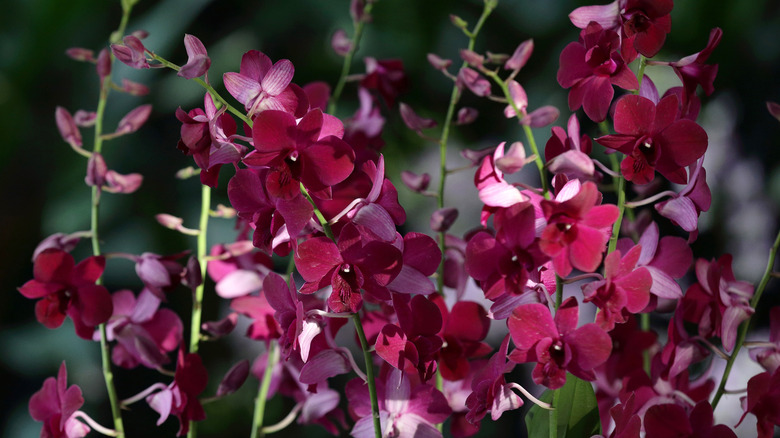
In gardens and elsewhere, orchids are largely ornamental, and the florists at the American Orchid Society explain that certain orchids adapt well to life in both the garden and containers. In places that don’t get frost, you can leave them in place year-round. And in climates where temperatures slip below 40 degrees Fahrenheit, you should relocate less robust varieties to an indoor windowsill where they can get the light they need to thrive. The best way to ensure your orchid will adapt is simple: They’re the ones that have already acclimated to your climate.
Barb Schmidt, chair of the education committee at the society, says the best place to use orchids is … everywhere. “I have hearty orchids in the ground growing year-round,” she told House Digest. “For people who like unique landscapes, hearty orchids make a great addition to a garden, because they’re just not seen very often, and you can have plants in your landscaping that most other gardeners won’t.”
Schmidt also points out that where you plant orchids also depends on the vitality of the genus you’ve chosen. “I live in Pennsylvania and my orchids do just fine in the ground in semi-shade,” she offers. “But that’s different from what might work for a gardener in Texas or Florida, where the climate is so much warmer. And you can find genus varieties that will fit any room of your house and not look anything alike because they’re different genuses.”
How to grow orchids
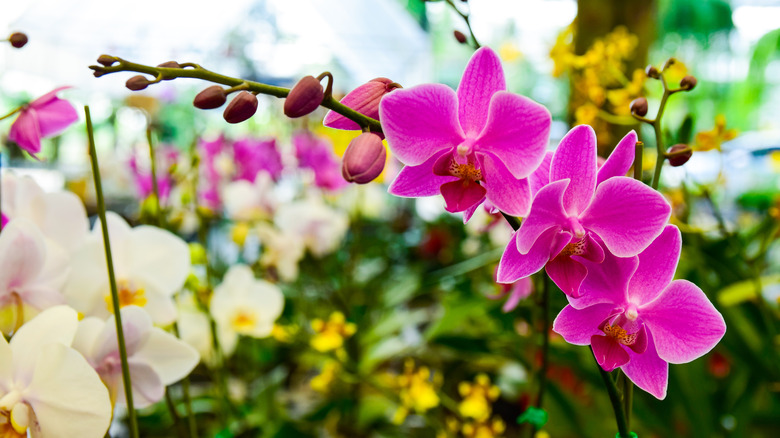
If you’re planting orchids in the ground, make sure you’ve chosen a genus that does well in your area, says Barbara Schmidt of the American Orchid Society — that’s crucial. Before they arrive (usually as a plant or a root, depending on the genus), carefully choose the location where you’ll plant them — which (like the mixture of potting soil, perlite, sand, peat, and manure) is going to be part of the instruction packet you’ll receive. Schmidt says any reputable seller will provide such a guide, and that will include where to plant them for shade and light, how deep they should be planted, and other pertinent details.
The challenge in growing orchids in containers is part of the reward, say the experts at Gardeners Supply Company. They caution that some are next-to-impossible to keep alive, let alone blooming — even for professional florists. However, you can nudge the odds in your favor by starting where you might have the advantage: Choose the most mature orchids affordable, they say, because the younger they are, the more volatile they become.
Country Living recommends starting your orchids indoors. These plants appreciate indirect bright light and windows facing south or east, as they provide the best combinations of light and shade. Orchids welcome LED lights as well. Since you’re basically relocating the plant, planting in a container is identical to repotting, which is explained below.
How to care for orchids
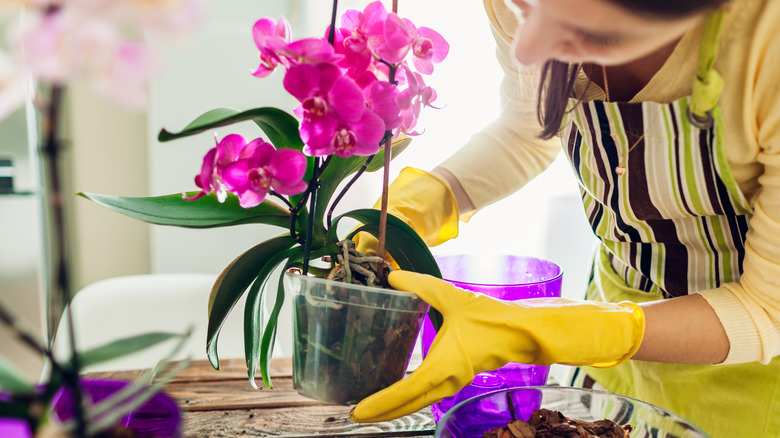
Mariia Boiko/Shutterstock
There are numerous mistakes you can make in caring for orchids — and growers cutting corners is one way the plants get their reputation as difficult. Well + Good will take you step-by-step through the process of maintaining your orchid, and their list starts with choosing the right mix for potting. Since so many species grow on tree bark, it’s best to approximate their natural habitat, and there are mixes which do that. Orchids do best if repotted every alternating year.
Second, make sure your plant gets indirect bright light. Remember that orchids love the dappled shade under bright sun that comes with their attachment to trees. Again, facing east is best. Water orchids regularly, not heavily, and not more than once a week. Misting can lead to rot and spotting, so that’s strongly discouraged. What works best, they say, is to place the grow pot under a slow-running faucet for no more than 15 seconds. You might place a humidifier in the room as well, since it helps replicate tropical conditions.
Make sure you take extra care not to cut your plant’s roots, because you will definitely be interfering with the orchid’s health. And lastly, orchids (particularly the genuses most commonly sold for indoor use) typically bloom once a year. When your flower has wilted or fallen off, you can gently prune the remains away, water slightly less often, and enjoy the plant as is until the next blooming season.
Varieties of orchids
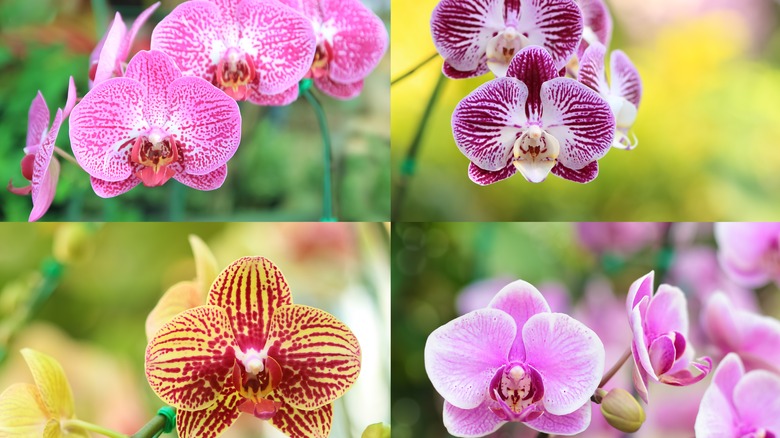
prapann/Shutterstock
Since orchids have been around for roughly 112 million years, as Barbara Schmidt of the American Orchid Society told House Digest, they’ve had time to travel and diversify. In fact, they’re found on every continent except Antarctica. One variety or another will grow anywhere that isn’t permanently dry or frozen. Botanists won’t say they agree on the exact number of species, but there’s a general consensus that the number ranges between 25,000 and 30,000, with more than 880 plant genera.
Orchids vary not only in shape and color, but also in size: In the cloud forests of Mexico, there’s an 0.5 centimeter-tall genus called Platystele that blooms with flowers that are only 0.5 millimeter-wide. By contrast, Asia boasts the largest orchid (in the Grammatophyllum genus), which can grow to reach 100 feet tall and displays flowers some 5 to 8 inches wide.
Although they appear in nature across a wide spectrum of climatic environments, most of the orchids sold for consumer use indoors hail from tropical and sub-tropical regions of Australia, India, Asia, and South and Central America. Of those, most are evergreen, although there are a few (including some Dendrobium and Lycaste) that are deciduous. Among the most popular in Western culture are the Cattleya orchids, which alone incorporate approximately 120 species (via Better Gro). These include the much-beloved range of corsage orchids because they are so often used as an appealing visual accent in formalwear.
Are orchids toxic?
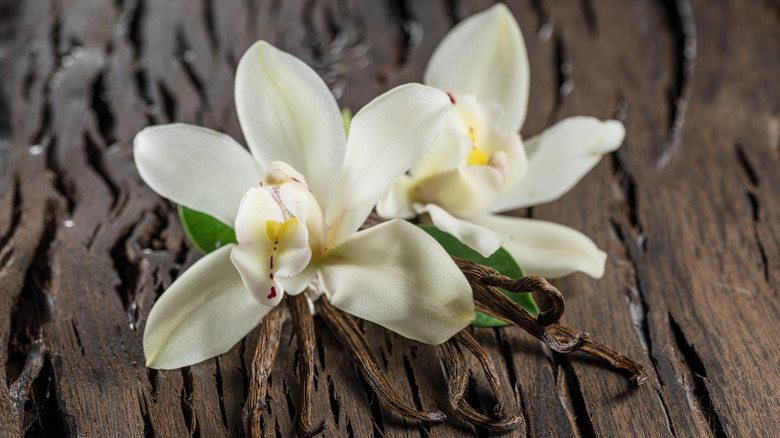
Valentyn Volkov/Shutterstock
The varieties of orchids sold for display and growth in the U.S. are not considered toxic to cats, dogs, or humans — so say the experts at Planted Shack. Smaller animals and babies, who are among the most vulnerable, have been known to experience stomach upset and vomiting if they’ve ingested too much, but these are exceptions to the rule.
In point of fact, orchids provide one of human beings’ favorite edibles: vanilla, which is extracted from Vanilla Orchids and used in recipes throughout the world; these allow alcohol, baked goods and frozen treats to take their flavors to the next level. But keep in mind that this toxicity advice applies to those sold domestically, as most of those grown here are perfectly safe for humans to consume. But, with up to 30,000 discrete orchid plants, scientists have yet to ascertain the toxicity of every single variant — and, the site admonishes, that doesn’t even count those hybrids yet to be catalogued or that might appear in the future.
How to repot orchids
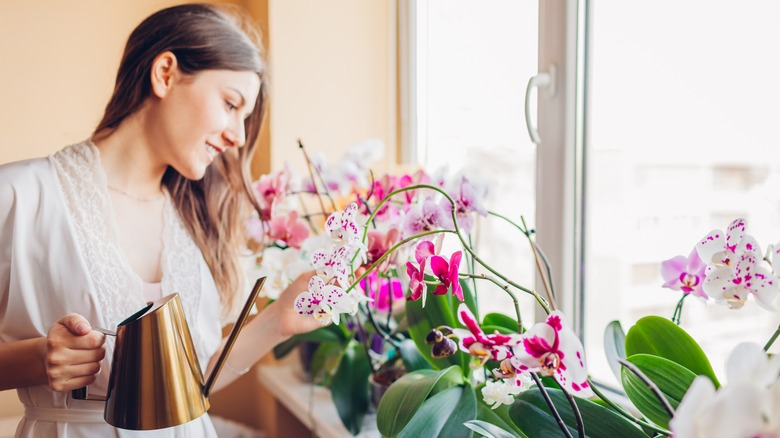
Mariia Boiko/Shutterstock
Never attempt to repot a plant while it’s flowering. Full stop. Enjoy the beauty of your orchid in bloom and wait. Once your flower has wilted, you can use clean shears to clip the spike and begin replanting. If you see white roots appearing over the edges of your container, you know your orchid is outgrowing its home. If you see the roots are beginning to rot, that may be another sign that the container is too full to properly drain. Be mindful that orchids are very specialized flowers that require placement in a mixture that is friendly to the species you’ve chosen. They can include such ingredients as charcoal, Styrofoam, or pine bark.
When repotting, follow the steps set forth by The Spruce. First, lift the plant from its pot and gently take off as much moss as you’re able. Examine the roots; they should be firm and white, with a growing point that’s small and green. Roots that are rotten, shriveled, or blackened should be separated now. Then set your plant into its new pot and surround it with the appropriate mixture. Make sure that it’s secure, but not anchored completely. The plant will send roots out to cling to the pot on its own eventually.
Now that the plant is repotted, find an east-facing window that provides mild sunlight in the morning. You’ll find placing a gravel-filled tray underneath the plant provides added humidity and a place to catch runoff after watering.



